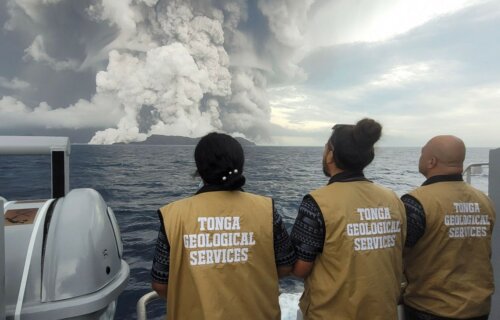CAMBRIDGE, United Kingdom —The world is “woefully underprepared” for a huge volcanic eruption which could cause civilization to collapse, a new study warns.
Researchers in the United Kingdom say there is a one in six chance of a massive magnitude seven eruption happening in the next century. This type of eruption would have seismic consequences for the world’s climate and food supply.
The University of Cambridge team say there is a “major misconception” that the risk of major eruptions is low. The effect of such a huge eruption would be similar to that of a one-kilometer-wide asteroid hitting the Earth, but the chances of a massive eruption are a lot higher than the combined chances of an asteroid or comet striking the planet.
However, the team believes society can take steps to stop complete devastation including better surveillance, better public education, and magma manipulation. They say that, while hundreds of millions of dollars go towards preparing for an asteroid striking Earth, not enough is happening to prepare for a massive volcanic eruption.
Recent eruptions are a warning sign
An eruption on the Pacific Island of Tonga in January was the largest ever recorded by modern instruments. If the eruption lasted longer, released more gas or ash, or happened in an area near critical infrastructure, the consequences could have been devastating.
An eruption 10 to 100 times the size of the Tonga blast happens once every 625 years, twice as often as previously thought by scientists. The last magnitude seven eruption happened in Indonesia in 1815. It killed 100,000 people and caused global temperatures to drop by a degree, leading to crop failures that resulted in famine, violent uprisings, and disease epidemics.
The hit to the economy would be in the trillions and comparable in size to the coronavirus pandemic. The researchers say that, to help prepare, society needs to know where massive eruptions could happen.
Over the past 60,000 years, researchers have only discovered the locations of a handful of the 97 eruptions classified as large magnitude on the “volcano explosivity index,” meaning there could be scores of extremely dangerous volcanoes around the world which scientists don’t know about.
Only 27 percent of eruptions since 1950 have had a seismometer anywhere near them, and only a third of that data has been fed into the global database for “volcanic unrest.”

‘We are completely underestimating the risk’
The team wants to study the how aerosols created by a massive eruption could be neutralized and how pockets of magma underneath the Earth could be manipulated.
“Data gathered from ice cores on the frequency of eruptions over deep time suggests there is a one-in-six chance of a magnitude seven explosion in the next one hundred years. That’s a roll of the dice,” says study co-author and CSER researcher Dr. Lara Mani, an expert in global risk, in a university release.
“Such gigantic eruptions have caused abrupt climate change and collapse of civilizations in the distant past.”
“Hundreds of millions of dollars are pumped into asteroid threats every year, yet there is a severe lack of global financing and coordination for volcano preparedness,” Mani adds. “This urgently needs to change. We are completely underestimating the risk to our societies that volcanoes pose.”
“The Tonga eruption was the volcanic equivalent of an asteroid just missing the Earth, and needs to be treated as a wake-up call,” Mani continues.
“Volcanologists have been calling for a dedicated volcano-monitoring satellite for over twenty years,” Mani says. “Sometimes we have to rely on the generosity of private satellite companies for rapid imagery. The current underinvestment in responding to this risk is simply reckless.”
“The last magnitude seven eruption was in 1815 in Indonesia,” adds co-author Dr. Mike Cassidy, a volcano expert and visiting CSER researcher, now at the University of Birmingham.
“We now live in a world with eight times the population and over forty times the level of trade. Our complex global networks could make us even more vulnerable to the shocks of a major eruption.”
“We may not know about even relatively recent eruptions due to a lack of research into marine and lake cores, particularly in neglected regions such as Southeast Asia,” Cassidy concludes. “Volcanoes can lie dormant for a long time, but still be capable of sudden and extraordinary destruction.”
The findings are published in the journal Nature.
South West News Service writer Gwyn Wright contributed to this report.

